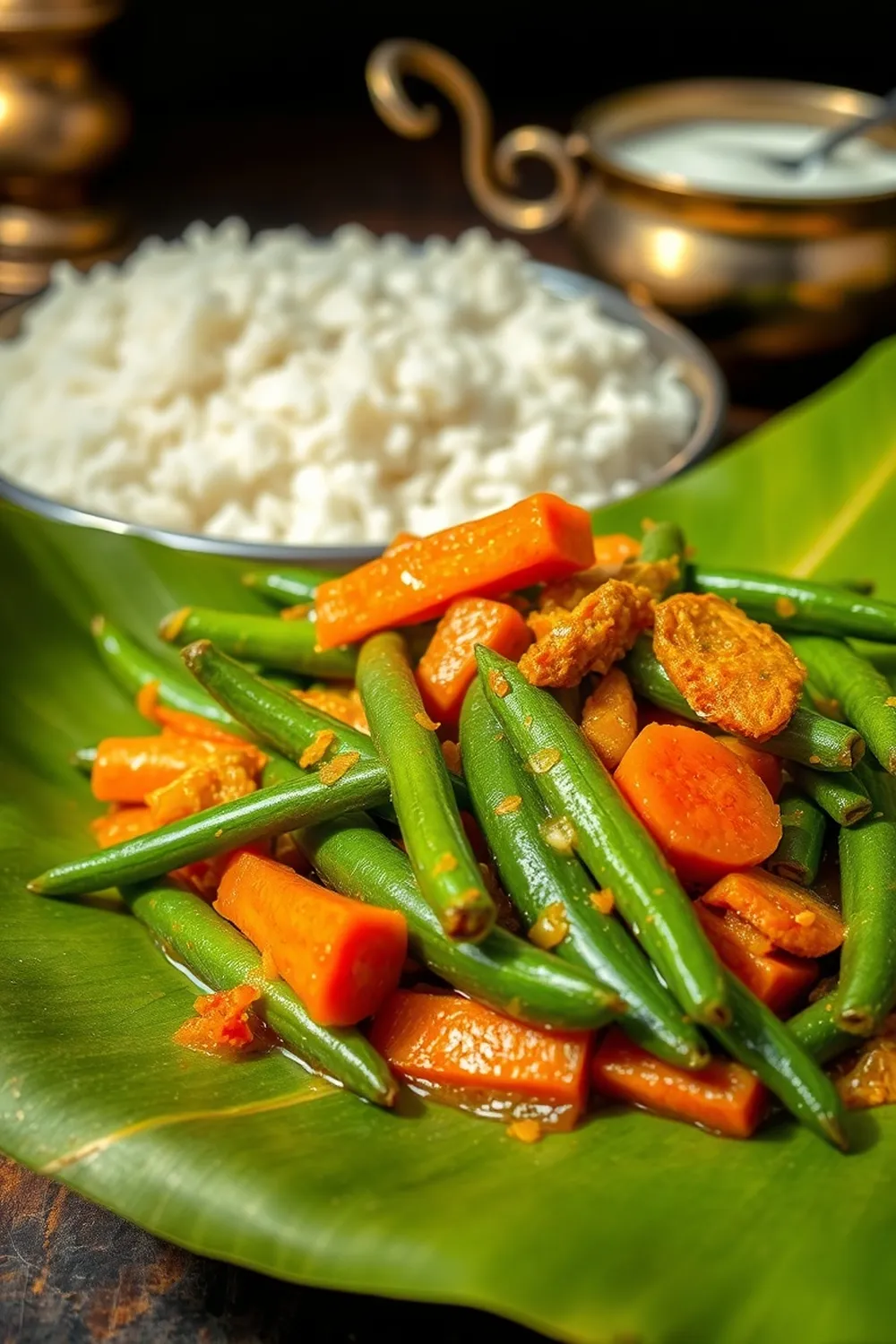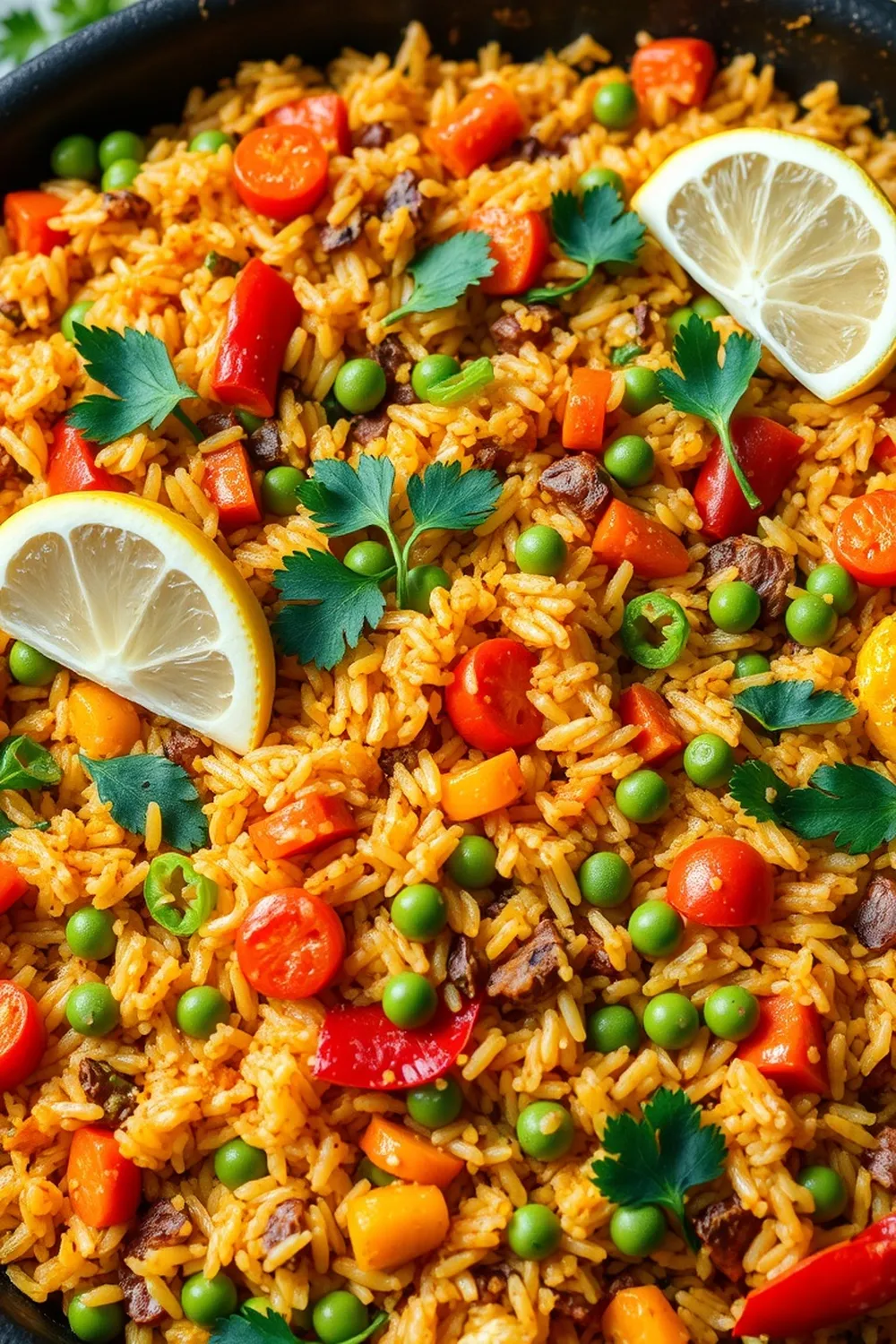- Rinse 1 cup broken rice and 1/2 cup moong dal. Drain and set aside.
- Heat ghee in a pressure cooker. Add cumin seeds, tej patta, cinnamon, cloves, and cardamom. Sauté until fragrant.
- Add chopped onions and sauté until translucent.
- Stir in ginger-garlic paste and sauté until raw aroma disappears.
- Add tomatoes and green chilies. Sauté for 1-2 minutes.
- Mix in chopped vegetables, turmeric, red chili powder, and asafoetida. Sauté for 1 minute.
- Add rinsed rice and moong dal. Combine well with vegetables and spices.
- Pour 2 cups water (adjust for desired consistency) and season with salt.
- Pressure cook for 14-15 minutes (7-8 whistles). Let pressure release naturally.
- Garnish with coriander leaves and serve hot with yogurt, pickle, or papad.
- Calories:332 kcal25%
- Energy:1389 kJ22%
- Protein:11 g28%
- Carbohydrates:55 mg40%
- Sugar:6 mg8%
- Salt:31 g25%
- Fat:7 g20%
Last Updated on 2 months by Neha Deshmukh
Broken Rice & Moong Dal Recipe – Authentic Indian Khichdi with Veggies
Hey everyone! Today, I’m sharing a recipe that’s close to my heart – a comforting, nourishing bowl of Khichdi. It’s the kind of dish my nani (grandmother) would make when I was feeling under the weather, and honestly, it still feels like a warm hug in a bowl. This isn’t just any Khichdi, though; we’re making a delicious version with broken rice, moong dal, and a generous helping of veggies. It’s perfect for a cozy weeknight dinner or a light, satisfying meal any time of day.
Why You’ll Love This Recipe
This Khichdi is more than just a meal; it’s a feeling. It’s incredibly easy to digest, packed with protein, and bursting with flavor. Plus, it’s wonderfully versatile – you can easily adapt it to your liking with different vegetables and spice levels. It’s a complete meal in one pot, which means fewer dishes! What’s not to love?
Ingredients
Here’s what you’ll need to create this comforting Khichdi:
- ?? cup broken rice
- ?? cup moong dal
- 1 tablespoon Ghee (about 15ml)
- ?? teaspoon cumin seeds
- 1 tej patta (Indian bay leaf)
- ?? inch cinnamon stick
- 2 cloves
- 2 green cardamoms
- ?? cup chopped onion
- 1 teaspoon Ginger Garlic Paste (about 5ml)
- ?? cup chopped tomatoes
- 1-2 green chilies
- 1-1.25 cups mixed chopped veggies (carrots, peas, beans, potatoes work well!)
- ?? teaspoon turmeric powder
- ?? teaspoon red chili powder
- 1 pinch asafoetida (hing)
- 2 cups water (about 480ml)
- Salt to taste
Ingredient Notes
Let’s talk ingredients! A few things can really elevate this Khichdi:
- Moong Dal: I prefer yellow moong dal for its digestibility and mild flavor. It’s a fantastic source of protein and is considered a sattvic food in Ayurveda, meaning it’s calming and nourishing.
- Broken Rice (Chaval): Using broken rice is key for that classic Khichdi texture. It cooks faster and becomes beautifully soft and creamy. I usually use regular broken rice, but you can experiment with different varieties.
- Vegetable Variations: Traditionally, Khichdi recipes vary regionally. In some parts of India, you’ll find it made with just lentils and rice, while others include a rainbow of vegetables. Feel free to use whatever seasonal veggies you have on hand – cauliflower, spinach, or even pumpkin would be lovely!
- Ghee is Gold: Don’t skimp on the ghee! It adds a richness and aroma that’s simply irreplaceable. Ghee isn’t just about flavor, though; it’s also considered very healthy in Ayurveda. If you’re avoiding ghee, you can use oil, but the flavor profile will change.
Step-By-Step Instructions
Alright, let’s get cooking!
- First, give the ?? cup broken rice and ?? cup moong dal a good rinse under cold water. Drain them well and set aside. This helps remove excess starch and makes for a lighter Khichdi.
- Now, heat 1 tablespoon of ghee in a pressure cooker over medium heat. Once it’s hot, add the cumin seeds, tej patta, cinnamon, cloves, and cardamom. Let them sizzle for a few seconds until they become fragrant – this is where the magic begins!
- Add the ?? cup chopped onion and sauté until it turns translucent and slightly golden.
- Stir in 1 teaspoon of ginger-garlic paste and sauté until the raw aroma disappears. You’ll know it’s ready when it smells wonderfully savory.
- Add the ?? cup chopped tomatoes and 1-2 green chilies (depending on your spice preference). Sauté for 1-2 minutes until the tomatoes soften slightly.
- Time for the veggies! Add 1-1.25 cups of your chopped vegetables, along with ?? teaspoon turmeric powder, ?? teaspoon red chili powder, and a pinch of asafoetida (hing). Sauté for another minute, letting the spices coat the vegetables.
- Add the rinsed rice and moong dal to the pressure cooker. Mix everything together well, ensuring the rice and dal are coated with the veggies and spices.
- Pour in 2 cups of water (you can adjust this depending on how thick or thin you like your Khichdi). Season with salt to taste.
- Close the pressure cooker lid and cook for 14-15 minutes (about 7-8 whistles). Once the pressure releases naturally, open the lid carefully.
- Garnish with fresh coriander leaves and serve hot with a dollop of yogurt, your favorite pickle, or a side of papad.
Expert Tips
Want to make your Khichdi extra special? Here are a few tips I’ve learned over the years:
- Consistency is Key: If your Khichdi is too thick, add a little more hot water and simmer for a few minutes. If it’s too thin, simmer uncovered for a bit longer to allow some of the liquid to evaporate.
- Preventing Sticking: To prevent the Khichdi from sticking to the bottom of the pressure cooker, make sure the ghee is hot before adding the spices, and stir frequently during the initial sautéing stages.
- Flavor Boost: A squeeze of lemon juice right before serving can brighten up the flavors beautifully.
Variations
- Vegan Khichdi Adaptation: Simply substitute the ghee with vegetable oil. It won’t have the same rich flavor, but it will still be delicious!
- Gluten-Free Confirmation: This recipe is naturally gluten-free, making it a great option for those with dietary restrictions.
- Spice Level Adjustment: For a milder Khichdi, reduce or omit the green chilies and red chili powder. For a spicier kick, add a pinch of cayenne pepper or use hotter green chilies.
- Festival Adaptations: During Makar Sankranti or Bhogi, it’s customary to add sesame seeds and peanuts to Khichdi for extra warmth and flavor.
Serving Suggestions
Khichdi is incredibly versatile! Here are a few ways to enjoy it:
- With a side of cooling yogurt.
- Paired with a tangy pickle.
- Served with crispy papadums.
- Alongside a simple vegetable stir-fry.
Storage Instructions
Leftover Khichdi can be stored in an airtight container in the refrigerator for up to 3 days. Reheat gently on the stovetop or in the microwave. You might need to add a splash of water to loosen it up.
FAQs
Let’s answer some common questions:
- What is the best type of rice to use for Khichdi? Broken rice is the traditional choice, as it cooks quickly and creates a creamy texture.
- Can I make this Khichdi in an Instant Pot? Absolutely! Use the pressure cook/manual setting for 10-12 minutes, followed by a natural pressure release.
- How do I adjust the water level for a thicker or thinner consistency? Less water = thicker Khichdi. More water = thinner Khichdi. Start with 2 cups and adjust as needed.
- What vegetables are traditionally used in Khichdi? Peas, carrots, potatoes, and beans are common choices, but feel free to experiment!
- Can I add protein like chicken or mutton to this Khichdi? While not traditional, you certainly can! Add pre-cooked, shredded chicken or mutton along with the vegetables.
Enjoy this comforting bowl of Khichdi! I hope it brings you as much joy as it brings me. Let me know in the comments how it turns out for you!










